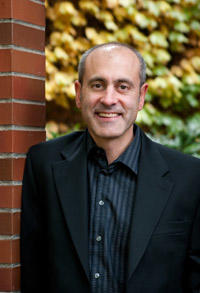Apostolidis '86 examines Mexican meatpackers' lives and political activism
Ordinary Americans have a lot to learn about how democracy should work from a group of Mexican immigrants and activists who mobilized a workers movement at a cattle-slaughtering and beef-processing facility in eastern Washington State, argues Paul Apostolidis ’86 in his book, Breaks in the Chain: What Immigrant Workers Can Teach America About Democracy (University of Minnesota Press). The immigrants, who suffered from dangerous working conditions, conducted a strike in 1999 at the facility and waged a successful campaign to take over their local union and make it more accountable to workers. A political science professor at Whitman College in Walla Walla, Wash., Apostolidis spoke with PAW’s Katherine Federici Greenwood.
What do meat processors do at work?
It is really shocking. … My friend who was one of the organizers of the union said he had never seen so many people working so hard and sweating so profusely in freezing cold conditions as they did inside the plant. That’s because of the speed of production. … The chain is the giant mechanical apparatus that moves the chunks of cattle carcass around the inside of the plant. The workers stand side-by-side at their workstations and they’ve got a hook in one hand. With the hooks they grab a hunk of carcass off of the chain and slap it down on the worktable in front of them. They have a knife in the other hand and they make one particular cut and then they hang it back on the chain and grab the next piece.
All of these work motions have been engineered down to seconds. In theory it is a tightly organized, scientifically run and efficient process. In practice what I’ve found [through the interviews he did nine years ago for the book] is there’s a tremendous amount of chaos on the inside of the plant. Because workers are getting injured so frequently, at any given workstation a job that should be done by three workers is being done by two.
The condition that was hardest for these workers and that most strongly motivated them to organize themselves as a group to try to change conditions and to get their own union to be more proactive and responsive was the injury problem. Sometimes there were dramatic injuries like getting kicked in the face [by an animal], or a worker who lost a large portion of his arm in a giant mechanical scissors machine that had not been properly maintained. But more often than not it’s injuries that come from repetitive motions, under tight stressful conditions. We’re not talking about muscle and tendon fatigue that a lot of us office workers get from standing over a computer. These are of a different order of magnitude. We interviewed one woman whose injured arm was swollen to twice the size of the other one.
What workers told us was that it was very difficult to get the company to take their injuries seriously. … Workers said that ordinarily they would meet resistance from line supervisors if they were hurt and needed to go to the infirmary. … Before the union really mobilized, the workers said the company was simply firing injured workers or making life difficult for them on the lines, prodding them to quit.
What did the group of immigrant worker activists at that processing facility change through restructuring their local union?
What I found most impressive about their movement was the way that they brought together this ethos of self-mobilization and self-assertion that involved the development of leaders who then would encourage ordinary workers to begin with the small steps of standing up for themselves or encouraging a coworker to insist on being allowed to go see a nurse if they were getting some resistance from a supervisor. … There was a real marriage between individual responsibility on the one hand and collective action on the other hand.
How did they democratize their union?
The electoral system in that particular local union had been moribund for quite some time and so when the reformers came in they [democratized their union] not only on the basis of mobilizing people to actually turn out and vote, but also multiplying the number of offices inside the union for which the people had to stand for elections rather than simply being appointed by a few key officers who were elected. That’s one part of it. But what I really stress in the book is a richer, deeper, more robust definition of democracy that involves active participation by the workers in really running the union for themselves. And that’s where their slogan — in English “we are the union” — is just so crucial for understanding this movement. The idea is that we run the union for ourselves — all the workers, not just the few people who are at the head of the movement.
What can those Mexican-American workers teach all of us about democracy?
Their ethos of running things for yourself has a lot to teach ordinary Americans. We’ve lost sight in this country of some of these basic democratic values. And I think that’s indicated by the number of people who perceive government as something alien and hostile to the people — when the idea from our founding is that a democratic government [is one in which] people govern themselves. So it’s the idea of personal responsibility and building that into a sense of being able to act as a group and make things better.
[In this book] I’m trying to get people to think about what democracy really means and how immigrants are so often presumed to be ignorant of what democracy means. If you look at the conversations around immigration reform, the presupposition is that they need to be taught how to be good Americans. And the fact of the matter is when you look at a struggle like this one, you see what Americans can learn from these folks who came from elsewhere.
We also need to look more carefully at our food production system and understand the ways that the normal operation of the food processing system in our country depends on the misery and suffering of immigrant workers.
Interview has been condensed.














No responses yet